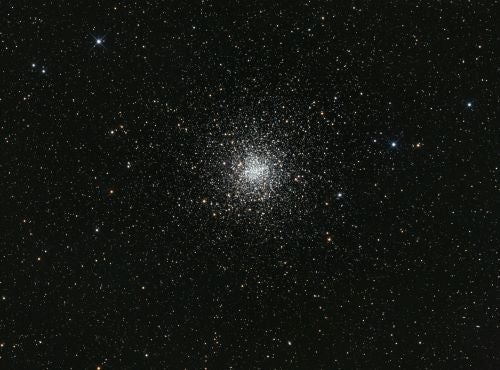Like Orion, Scorpius is also famous as the home to one of the largest stars visible to the naked eye. Antares (Alpha [α] Scorpii) is a monster of a star, a spectral-type M1.5 red supergiant. Compared to the Sun, its outer edge would encompass the orbit of Mars.
Through binoculars, Antares looks like a glimmering ruby surrounded by countless grains of diamond dust. Depending on Earth’s atmospheric turbulence, Antares may look more like a flashing kaleidoscope of colors. At their most turbulent, those arrhythmic pulses can have an almost hypnotic effect.
After snapping out of the Antarian trance, shift your attention just a degree to the star’s
west. There, you will find a hidden surprise: a small puff of celestial cotton afloat amongst the stars. That’s one of my favorite globular clusters: M4, a colossus of some 100,000 stars.
M4 was discovered in 1746 by Swiss astronomer Jean-Philippe Loys de Chéseaux. But, in a sort of “publish or perish,” no one else knew about it until French astronomer Nicolas-Louis de Lacaille independently found it and published an account six years later. Charles Messier added it to his fledgling catalog in 1764, noting it as a “cluster of very small stars.” Indeed, M4 is the only globular among the 29 in his catalog that he saw as anything more than a nebulous smudge.
At magnitude 5.8, M4 appears as bright as M13 in Hercules, even though it is not as large or as concentrated. It appears so bright not because of its size or girth, but rather its distance. M4 is the closest globular to our solar system, about 5,600 light-years away. M13 is about 22,000 light-years away. M4 would appear even brighter were it not for all of the intervening clouds of interstellar dust between us and it, which muffle the view.
M4 is arguably the easiest globular in the sky to locate, owing to its proximity to such a bright star. But that can also make it a challenge to see through lower-power binoculars for the same reason. Antares can be distracting. If you have a problem seeing M4, move Antares just off the eastern (likely the left) edge of the field and try again. Once you spot it, you’ll wonder how you ever missed it in the first place.
Through my 16x70s, M4 reveals a feature that is unique among globulars: a bright central “bar.” In reality, this bar is formed by a coincidental queue of brighter-than-average stars. Some of those stars are resolvable in 70mm and larger binoculars if you look carefully using averted vision.
Those same giant binoculars just might show a second, far fainter globular cluster that appears even closer to Antares. NGC 6144 often goes unnoticed because of its proximity to both the star and M4. Messier missed it altogether, but it was finally noticed by William Herschel in May 1784. Lying some 30,000 light-years away, NGC 6144 is also subdued by intervening clouds of dust. With careful scrutiny, I’ve seen it through my 16x70s by first moving the distracting glare of Antares out of the field. Be aware that any interference from sky haziness, or dust or dew on a lens, will render it invisible.
If NGC 6144 proves difficult, try a more accessible Scorpion globular. M80 is fainter than M4, but far easier than NGC 6144. To find it, scan 4.5° northwestward through your binoculars from Antares to a position just east of the halfway point between Sigma (σ) and Nu (ν) Scorpii in the Scorpion’s head. There, we find M80 nestled among faint field stars and framed by Sigma and Nu, still in the field of most 10x and lower-power binoculars. Discovered by Messier on a winter morning in January 1781, M80 shines at 7th magnitude and appears about one-third as large as M4. In reality, however, M80 is both larger and more concentrated. It’s just farther away, at more than 32,000 light-years from us. Binoculars reveal a perfect sphere focusing to a brighter central core.
Buried within M80’s several hundred thousand stars are many so-called “blue stragglers.” These blue giant stars appear much younger than other cluster members, seemingly defying the cluster’s overall age. Studies conclude that these stars may have lost their cooler outer shells in close encounters with other stars, thereby exposing hotter inner shells.
Suggestions for future columns? Contact me through my website, philharrington.net. Until next time, remember that two eyes are better than one










